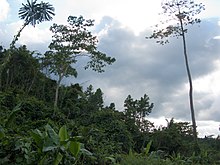
The flora of the Philippines boasts a diverse array of plant species given its location in the great Malaysian flora. The Malaysian Phytogeographic zone is considered to be one of the most important centers for plant diversity because of the multitude and variance of species occupying that zone.[1] The archipelago is isolated by a continental and deep ocean.[2]
At the very least, one-third of the more than 9,250 vascular plant species native to the country are endemic.[3] There are, however, no plant families endemic to the country.[citation needed] The families of gingers, begonias, gesneriads, orchids, pandans, palms, and dipterocarps are particularly high in endemic species. For example, two-thirds of the 150 species of palms present in the country are found nowhere else in the world. There are over 137 genera and about 998 species of orchids so far recorded in the Philippines as of 2007.[4]
The broad lowland and hill rain forests of the Philippines, which are mostly gone today,[5] were dominated by at least 45 species of dipterocarps. These massive trees were abundant to up to 1,000 meters above sea level. Considering the dipterocarps originated in India and Malaysia, the existence of the trees in the archipelago demonstrates a connection between the Philippines and western Malaysia.[6] Other important tree species here include giant figs, which provide food for fruit bats, parrots, and monkeys, and Pterocarpus indicus, which like the dipterocarps, is valued for its timber.
Due to environmental changes, finding new species has become more urgent so the island can have an accurate reading of flora and fauna record.[7]
A few species of Rafflesia are found in the Philippines,[8] one of them being Rafflesia philippensis.[9]
List[edit]
- Abaca – Musa textilis
- Acacia
- Almaciga – Agathis philippinensis
- Atis – Annona squamosa
- Ayangile – Acacia confusa
- Banaba – Lagerstroemia speciosa
- Banana
- Breadfruit – Artocarpus altilis
- Calachuchi – Plumeria obtusa
- Dama de Noche – Cestrum nocturnum
- Gumamela – Hibiscus rosa-sinensis
- Guyabano – Annona muricata
- Katmon - Dillenia philippinensis
- Kalamansanay - Terminalia calamansanai
- Kalamansi - Citrus x microcarpa
- Kamagong – Diospyros blancoi
- Kamantigi - Impatiens balsamina
- Kamantigi-gubat - Impatiens platypetala
- Kamatsile - Pithecellobium dulce
- Kamuning - Murraya paniculata
- Langka – Artocarpus heterophylla
- Lanzones – Lansium parasiticum
- Lasong-kainan - Blighia sapida
- Lila-lilahan - Hibiscus radiatus
- Luya-luyahan - Curcuma zeodaria
- Malakamantigi - Impatiens walleriana
- Malapaputok - Crossandra infundibuliformis
- Mahogany
- Makopa – Syzygium samarangense
- Mangga – Mangifera indica
- Molave – Vitex parviflora
- Narra – Philippine cedar; Pterocarpus indicus
- Niyog – Cocos nucifera
- Nipa – Nypa fruticans
- Orchid – Phalaenopsis hieroglyphica
- Paliparang-upo- Alsomitra macrocarpa
- Pineapple – Ananas comosus
- Philippine Lily – Lilium philippinense
- Pomelo – Citrus maxima
- Rafflesia
- Rattan – Calamus
- Sampaguita – Jasminum sambac
- Santan – Ixora coccinea
- Sugarcane
- Talong punay – Datura metel
- Tayabak – Strongylodon macrobotrys
- Tobacco
- Trompeta - Brugmansia suaveolens, Brugmansia arborea
- Tuba-tuba – Jatropha curcas
- Ube – Dioscorea alata
- Waling-waling – Euanthe sanderiana
- Yakal – Shorea astylosa
- Ylang-ylang – Cananga odorata
See also[edit]
References[edit]
- ^ Stuessy, Tod F.; Sohmer, S. H. (1996). Sampling the Green World: Innovative Concepts of Collection, Preservation, and Storage of Plant Diversity. Columbia University Press. ISBN 978-0-231-10136-3.
- ^ Jones, Andrew W.; Kennedy, Robert S. (2008-10-30). "Evolution in a tropical archipelago: comparative phylogeography of Philippine fauna and flora reveals complex patterns of colonization and diversification: PHILIPPINE EVOLUTIONARY HISTORY". Biological Journal of the Linnean Society. 95 (3): 620–639. doi:10.1111/j.1095-8312.2008.01073.x. S2CID 83860043.
- ^ Das, Indraneil; Tuen, Andrew Alek, eds. (2016). Naturalists, Explorers and Field Scientists in South-East Asia and Australasia. Springer. p. 243. ISBN 978-3-319-26161-4.
- ^ Agoo, Esperanza Maribel G. (2007). "Status of Orchid Taxonomy Research in the Philippines" (PDF). Philippine Journal of Systematic Biology. 1. Retrieved July 23, 2020.
- ^ Langenberger, Gerhard; Martin, Konrad; Sauerborn, Joachim (April 2006). "Vascular Plant Species Inventory of a Philippine Lowland Rain Forest and its Conservation Value". Biodiversity and Conservation. 15 (4): 1271–1301. doi:10.1007/s10531-005-2576-4. ISSN 0960-3115. S2CID 24311228.
- ^ Charles C, Adams (1925). Significance of the Flora of the Philippines. American Geographical Society, Wiley. pp. 163–165.
- ^ Yeo, Darren; Cumberlidge, Neil; Klaus, Sebastian, eds. (2014-01-01), "A new species of Isolapotamon Bott, 1968 (Decapoda, Brachyura, Potamidae) from Mindanao, with notes on the Philippine Isolapotamon species", Advances in Freshwater Decapod Systematics and Biology, BRILL, pp. 135–159, doi:10.1163/9789004207615_009, ISBN 978-90-04-20761-5, retrieved 2021-12-06
- ^ Wikramanayake, Eric D.; et al. (2002). Terrestrial Ecoregions of the Indo-Pacific: A Conservation Assessment. Washington: Island Press. p. 146. ISBN 1-55963-923-7.
- ^ Barcelona, J. F.; Pelser, P. B.; Balete, D. S.; Co, L. L. (2009). "Taxonomy, Ecology, and Conservation Status of Philippine Rafflesia (Rafflesiaceae)" (PDF). Blumea. 54 (1): 77–93. doi:10.3767/000651909X474122.